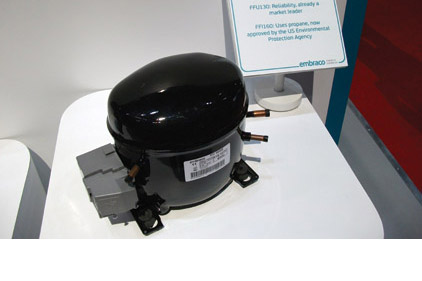
|
| Wider use of HC refrigerants is reflected in new components and EPA SNAP approval of several HCs, as reflected in this display at the recent AHR Expo in Chicago. |
Now that the Environmental Protection Agency (EPA) has greenlighted the use of a number of hydrocarbon (HC) refrigerants in certain refrigeration applications, many in the industry have questions about these refrigerants and their potential uses. Concerns include how contractors will accept refrigerants they may not be that familiar with and the learning curve to work with HCs. Many are also wondering about the possibilities of ever-expanding uses of HCs.
EPA SNAP Approval
The EPA document 40 CFR Part 82, titled “Protection of Stratospheric Ozone: Listing of Substitutes for Ozone-Depleting Substances — Hydrocarbon Refrigerants,” officially gave Significant New Alternatives Policy (SNAP) approval to R-290 (propane), R-600a (isobutene), and R-441A (a blend marketed by ComStar International as HCR 188c).
The approval initially comes with some limitations. These include charge sizes to 57 grams for household appliances, and 150 grams for commercial units and only for equipment specially designed for the approved HCs with ignition sources minimized and with no retrofitting allowed. EPA also requires warnings and labels to make those working on the equipment aware that the system contains a potentially flammable gas in the refrigeration system.
“The approval of these ‘new’ natural refrigerants in a very few specific uses is a harbinger of things to come as the industry seeks to balance its overall environmental impact of the equipment produced with safety and energy efficiencies,” said Mark Lowry, executive vice president of the Refrigeration Service Engineers Society (RSES), an association made up primarily of service technicians who could soon be working on HC systems — if some are not already doing so.
“While Europe and Asia have been using HCs in domestic appliances for more than 10 years, several countries have gone further into allowing charge sizes up to 9 pounds per circuit. That kind of system development definitely means service personnel will need to be trained more than ever on the details and safety aspects of working with these refrigerants,” Lowry said.
HC Growth Potential
For those involved in the manufacture of HCs, the current SNAP approval is just the beginning. In fact, EPA took the action in response to petitions from such end-user powerhouses as Ben & Jerry’s, General Electric, and True Manufacturing, among others.
In a statement about the EPA approval, Tecumseh Products Co. said, “The move provides both environmental benefits and inherent refrigeration system advantages. The final SNAP ruling will provide Tecumseh and its U.S. commercial refrigeration OEM customers new opportunities to differentiate by offering more environmentally-friendly product solutions.”
Safety and cost will also be factored in the growth of the use of the refrigerants. “Safety factors and applied cost will continue to be the market drivers relative to further acceptance,” said Keith Gifford, director of global marketing at Tecumseh.
“We’re already seeing some evaluations of central systems that may make sense to be decentralized for use with HC refrigerants.”
However, a cautionary note came from Brent Hoare, executive director of the Green Cooling Association of Australia, who was quoted in Hydrocarbons 21, a website devoted to natural refrigerant.
According to Hoare, “There can be little confidence that approval in other applications will happen any time soon, given the level of opposition to HCs in the U.S., and the onerous and cumbersome approvals process of the regulatory authorities.”
However, others are more optimistic that acceptance and approval for the use of HCs will continue to expand in the United States. On the same website, A.S. Trust & Holdings’ Richard Maruya, the inventor of R-441A was quoted as saying, “I am pleased that this approval gets us one step closer to bringing this energy efficient technology to many different consumer applications,” said
Gifford added, “Tecumseh has been developing and marketing compressors and condensing units that utilize hydrocarbon refrigerants for more than a decade, primarily in South America and Europe. Armed with this experience, we’ve been working with our U.S. OEM customers for months to develop new solutions that will incorporate hydrocarbon-ready compressors.”
Sidebar: The Safety Factor
Last September, Keith Gifford, director of global marketing at Tecumseh, conducted a webinar event in conjunction with The NEWS on the topic “What Every Refrigeration Technician Needs to Know About Hydrocarbon Refrigerants.”
In his webinar, Gifford outlined some of the safety precautions a technician should take when working with HCs, including:
• Always use proper monitoring and leak detection devices.
• Eliminate all potential sources of ignition before beginning service.
• Always use the proper “serial label” refrigerant for the system.
• Use solid-state type (non-sparking) and/or explosion proof (ex type) electrical components that are suitable for the application.
• Use a pressure relief valve and do not pressurize the system beyond 150 psig field leak test pressure.
• Fans installed inside or outside the refrigerated space should not produce electrical arcs, even when short circuited or blocked.
“The aftermarket/service transition will occur over time. There is time to prepare,” Gifford said. “With adequate safety precautions, HC dangers are easily manageable.”
Publication date: 02/27/2012









